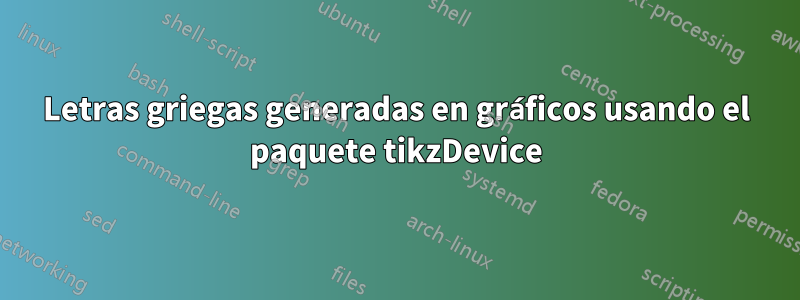
Con el siguiente código creo en Rstudio el archivo gamma0plot.tex. Luego en TexNicCenter en el figureentorno con el inputcomando cargo el archivo gamma0plot.texy genero un archivo .pdf. En este .pdf, el título del eje x es g1, ¿cómo mantener la letra griega $\gamma_{1}$al generar el archivo gamma0plot.texen lugar de g1? ¡Cualquier otra sugerencia para mejorar estos gráficos será bienvenida!
library(ggplot2)
library(grid)
grid.newpage()
require(tikzDevice)
# make sure the working directory is where you want your tikz file to go
setwd("D:/Área de Trabalho/teste")
# export plot as a .tex file in the tikz format
tikz('gamma0plot.tex', width = 6,height = 3,pointsize = 12) #define plot name size and font size
grid.newpage()
set.seed(000)
m11 <- matrix(rnorm(1000,0,1),1000,1)
df11 <- data.frame(m11)
names(df11) <- c("X")
library(ggplot2)
g1 <- ggplot(df11, aes(x=X))+coord_cartesian(ylim = c(0,0.6)) +
ggtitle("n=500")+
theme(plot.title = element_text(margin = margin(b = 2),size = 6,hjust = 0))
g1 <- g1+geom_histogram(aes(y=..density..), # Histogram with density instead of count on y-axis
binwidth=.5,
colour="black", fill="white",breaks=seq(-2, 2, by = 0.1))
g1 <- g1 + stat_function(fun=dnorm,
color="black",geom="area", fill="gray", alpha=0.1,
args=list(mean=mean(df11$X),
sd=sd(df11$X)))
g1 <- g1+ geom_vline(aes(xintercept=0, linetype="Valor Verdadeiro"),show.legend =TRUE)
g1 <- g1+ geom_vline(aes(xintercept=mean(df11$X, na.rm=T), linetype="Valor Estimado"),show.legend =TRUE)
g1 <- g1+ scale_linetype_manual(values=c("dotdash","solid")) # Overlay with transparent density plot
g1 <- g1+ xlab(expression(paste(gamma[1])))+ylab("")
g1 <- g1+ theme(plot.margin=unit(c(0.5, -0.5, 0.5, 0.5), units="line"),
legend.text=element_text(size=6),
legend.position = c(0, 0.97),
legend.justification = c("left", "top"),
legend.box.just = "left",
legend.margin = margin(0,0,0,0),
legend.title=element_blank(),
legend.direction = "vertical",
legend.background = element_rect(colour = NA,fill="transparent", size=.5, linetype="dotted"),
legend.key = element_rect(colour = "transparent", fill = NA))
g1 <- g1+ guides(linetype = guide_legend(override.aes = list(size = 0.5)))
# Adjust key height and width
g1 = g1 + theme(
legend.key.height = unit(.3, "cm"),
legend.key.width = unit(0.5, "cm"))
# Get the ggplot Grob
gt1 = ggplotGrob(g1)
# grid.ls(grid.force(gt)) # To get a list of editable grobs
# Edit the relevant keys
library(grid)
gt1 <- editGrob(grid.force(gt1), gPath("key-[3,4]-1-[1,2]"),
grep = TRUE, global = TRUE,
x0 = unit(0, "npc"), y0 = unit(0.5, "npc"),
x1 = unit(1, "npc"), y1 = unit(0.5, "npc"))
###############################################
m12 <- matrix(rnorm(2000,0,1),2000,1)
df12 <- data.frame(m12)
names(df12) <- c("X")
library(ggplot2)
g2 <- ggplot(df12, aes(x=X)) +coord_cartesian(ylim = c(0,0.6))+
ggtitle("n=1000")+
theme(plot.title = element_text(margin = margin(b = 2),size = 6,hjust = 0))
g2 <- g2+geom_histogram(aes(y=..density..), # Histogram with density instead of count on y-axis
binwidth=.5,
colour="black", fill="white",breaks=seq(-2, 2, by = 0.1))
g2 <- g2 + stat_function(fun=dnorm,
color="black",geom="area", fill="gray", alpha=0.1,
args=list(mean=mean(df12$X),
sd=sd(df12$X)))
g2 <- g2+ geom_vline(aes(xintercept=0, linetype="Valor Verdadeiro"),show.legend =TRUE)
g2 <- g2+ geom_vline(aes(xintercept=mean(df12$X, na.rm=T), linetype="Valor Estimado"),show.legend =TRUE)
g2 <- g2+ scale_linetype_manual(values=c("dotdash","solid")) # Overlay with transparent density plot
g2 <- g2+ xlab(expression(paste(gamma[1])))+ylab("")
g2 <- g2+ theme(plot.margin=unit(c(0.5, -0.5, 0.5, -0.5), units="line"),
legend.text=element_text(size=6),
legend.position = c(0, 0.97),
legend.justification = c("left", "top"),
legend.box.just = "left",
legend.margin = margin(0,0,0,0),
legend.title=element_blank(),
legend.direction = "vertical",
legend.background = element_rect(colour = NA,fill="transparent", size=.5, linetype="dotted"),
legend.key = element_rect(colour = "transparent", fill = NA))
g2 <- g2+ guides(linetype = guide_legend(override.aes = list(size = 0.5)))
# Adjust key height and width
g2 = g2 + theme(
legend.key.height = unit(.3, "cm"),
legend.key.width = unit(0.5, "cm"))
# Get the ggplot Grob
gt2 = ggplotGrob(g2)
# # grid.ls(grid.force(gt)) # To get a list of editable grobs
#
# Edit the relevant keys
library(grid)
gt2 <- editGrob(grid.force(gt2), gPath("key-[3,4]-1-[1,2]"),
grep = TRUE, global = TRUE,
x0 = unit(0, "npc"), y0 = unit(0.5, "npc"),
x1 = unit(1, "npc"), y1 = unit(0.5, "npc"))
####################################
m13 <- matrix(rnorm(3000,0,1),3000,1)
df13 <- data.frame(m13)
names(df13) <- c("X")
library(ggplot2)
g3 <- ggplot(df13, aes(x=X)) +coord_cartesian(ylim = c(0,0.6)) +
ggtitle("n=2000")+
theme(plot.title = element_text(margin = margin(b = 2),size = 6,hjust = 0))
g3 <- g3+geom_histogram(aes(y=..density..), # Histogram with density instead of count on y-axis
binwidth=.5,
colour="black", fill="white",breaks=seq(-2, 2, by = 0.1))
g3 <- g3 + stat_function(fun=dnorm,
color="black",geom="area", fill="gray", alpha=0.1,
args=list(mean=mean(df13$X),
sd=sd(df13$X)))
g3 <- g3+ geom_vline(aes(xintercept=0, linetype="Valor Verdadeiro"),show.legend =TRUE)
g3 <- g3+ geom_vline(aes(xintercept=mean(df13$X, na.rm=T), linetype="Valor Estimado"),show.legend =TRUE)
g3 <- g3+ scale_linetype_manual(values=c("dotdash","solid")) # Overlay with transparent density plot
g3 <- g3+ xlab(expression(paste(gamma[1])))+ylab("")
g3 <- g3+ theme(plot.margin=unit(c(0.5, 0.5, 0.5, -0.5), units="line"),
legend.text=element_text(size=6),
legend.position = c(0, 0.97),
legend.justification = c("left", "top"),
legend.box.just = "left",
legend.margin = margin(0,0,0,0),
legend.title=element_blank(),
legend.direction = "vertical",
legend.background = element_rect(colour = NA,fill="transparent", size=.5, linetype="dotted"),
legend.key = element_rect(colour = "transparent", fill = NA))
g3 <- g3+ guides(linetype = guide_legend(override.aes = list(size = 0.5)))
#
#
# Adjust key height and width
g3 = g3 + theme(
legend.key.height = unit(.3, "cm"),
legend.key.width = unit(0.5, "cm"))
# Get the ggplot Grob
gt3 = ggplotGrob(g3)
# grid.ls(grid.force(gt)) # To get a list of editable grobs
# Edit the relevant keys
library(grid)
gt3 <- editGrob(grid.force(gt3), gPath("key-[3,4]-1-[1,2]"),
grep = TRUE, global = TRUE,
x0 = unit(0, "npc"), y0 = unit(0.5, "npc"),
x1 = unit(1, "npc"), y1 = unit(0.5, "npc"))
library(gridExtra)
grid.arrange(gt1, gt2, gt3, widths=c(0.3,0.3,0.3), ncol=3)
# export plot as a .tex file in the tikz format
dev.off() # export file and exit tikzDevice function
Respuesta1
Resolví el problema, solo usa:xlab("$\\gamma_{0}$")


